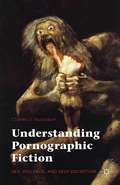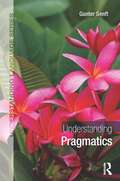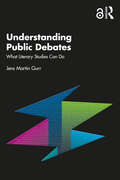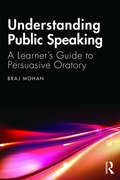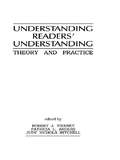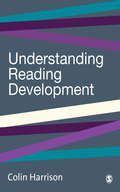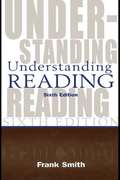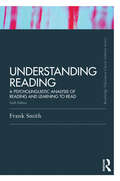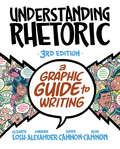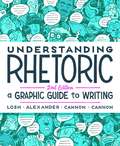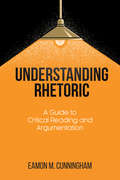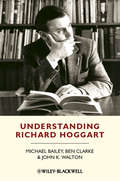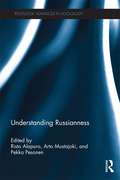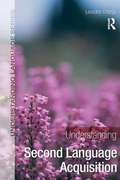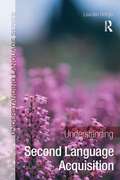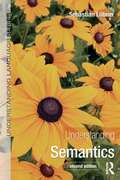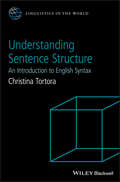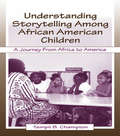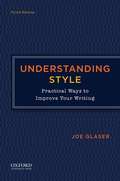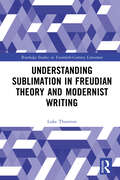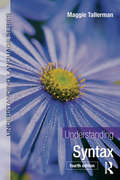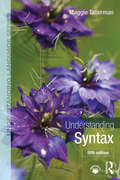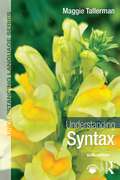- Table View
- List View
Understanding Politeness
by Dániel Z. Kádár Michael HaughPoliteness is key to all of our relationships and plays a fundamental part in the way we communicate with each other and the way we define ourselves. It is not limited only to conventional aspects of linguistic etiquette, but encompasses all types of interpersonal behaviour through which we explore and maintain our relationships. This groundbreaking exploration navigates the reader through this fascinating area and introduces them to a variety of new insights. The book is divided into three parts and is based on an innovative framework which relies on the concepts of social practice, time and space. In this multidisciplinary approach, the authors capture a range of user and observer understandings and provide a variety of examples from different languages and cultures. With its reader-friendly style, carefully constructed exercises and useful glossary, Understanding Politeness will be welcomed by both researchers and postgraduate students working on politeness, pragmatics and sociolinguistics more broadly.
Understanding Pornographic Fiction: Sex, Violence, and Self-Deception
by Charles NussbaumThis work defends two main theses. First, modern Western pornographic fiction functions as a self-deceptive vehicle for sexual or blood-lustful arousal; and second, that its emergence owes as much to Puritan Protestantism and its inner- or this-worldly asceticism as does the emergence of modern rationalized capitalism.
Understanding Pragmatics (Understanding Language)
by Gunter SenftUnderstanding Pragmatics takes an interdisciplinary approach to provide an accessible introduction to linguistic pragmatics. This book discusses how the meaning of utterances can only be understood in relation to overall cultural, social and interpersonal contexts, as well as to culture specific conventions and the speech events in which they are embedded. From a cross-linguistic and cross-cultural perspective, this book: debates the core issues of pragmatics such as speech act theory, conversational implicature, deixis, gesture, interaction strategies, ritual communication, phatic communion, linguistic relativity, ethnography of speaking, ethnomethodology, conversation analysis, languages and social classes, and linguistic ideologies incorporates examples from a broad variety of different languages and cultures takes an innovative and transdisciplinary view of the field showing linguistic pragmatics has its predecessor in other disciplines such as philosophy, psychology, ethology, ethnology, sociology and the political sciences. Written by an experienced teacher and researcher, this introductory textbook is essential reading for all students studying pragmatics.
Understanding Public Debates: What Literary Studies Can Do
by Jens Martin GurrBy historicizing and contextualizing them through readings of carefully selected literary texts, literary studies can contribute to understanding and rationalizing key debates waged in many pluralist societies today – whether on different conceptions of liberty, identity politics, historical commemoration, challenges of globalization or responses to climate change. Understanding Public Debates presents case studies including Milton's Paradise Lost, P.B. Shelley's 1820 Reform essay, Philip Roth's The Human Stain, the songwriting of Neil Young and Edward Young's 1720s Sea Odes, recent climate fiction as well as non-literary conflict narratives. Rather than mining texts for arguments for or against certain positions, this book is interested in how texts stage these debates by means of multiple perspectives, narrative situations or ambiguities. By suggesting how educators might use literary texts as conversation starters for more rational debates, the volume also contributes to Public Literary Studies. Three important fields are here brought together: (1) the study of societal debates and conflicts and the ways in which they challenge pluralist societies, (2) explorations of the societal functions of literature and of non-literary narratives and (3) discussions of the role and functions of literary studies. The book ends with ten crisp theses on how literary studies can contribute to understanding and rationalizing such conflictive debates.
Understanding Public Speaking: A Learner's Guide to Persuasive Oratory
by Braj MohanPublic speaking is a much coveted yet difficult art. This book illustrates the use of various linguistic devices and persuasive strategies with examples from the speeches of powerful orators in history. It systematically draws on the various approaches to public speaking and persuasive discourse to present new insights and techniques. The volume: Critically examines strategies of persuasive oratory. Draws on extensive investigation of a corpus of famous public speeches in history. Focuses on the needs of those who want to brush up their public speaking skills. The volume will be a key reference for aspiring civil servants, lawyers, business and corporate professionals, and politicians. It will be of great interest to scholars of linguistics, and political and business communication.
Understanding Readers' Understanding: Theory To Practice
by Patricia L. Anders Robert J. Tierney Judy Nichols MitchellThis collection features papers addressing current issues in reading comprehension from cognitive and linguistic perspectives. Organized into three sections, the volume investigates text considerations and reader-text interactions. Each paper presents a substantial and comprehensive review of theory and research related to cognition and reading comprehension.
Understanding Reading Development
by Colin HarrisonThis book focuses on how to understand reading processes and what it means to develop reading comprehension. With a wide-ranging theoretical basis, the author makes new connections between work in critical theory, cognitive psychology and literacy. Key features include: } how and why we read } evaluating response to reading } a whole-school approach to developing reading. This book is highly recommended to teachers, literacy coordinators and students and lecturers of masters and doctoral programmes with a reading or literacy focus.
Understanding Reading: A Psycholinguistic Analysis of Reading and Learning to Read
by Frank SmithUnderstanding Reading revolutionized reading research and theory when the first edition appeared in 1971 and continues to be a leader in the field. In the sixth edition of this classic text, Smith's purpose remains the same: to shed light on fundamental aspects of the complex human act of reading--linguistic, physiological, psychological, and social--and on what is involved in learning to read. The text critically examines current theories, instructional practices, and controversies, covering a wide range of disciplines but always remaining accessible to students and classroom teachers. Careful attention is given to the ideological clash that continues between whole language and direct instruction and currently permeates every aspect of theory and research into reading and reading instruction. To aid readers in making up their own minds, each chapter concludes with a brief statement of "Issues." Understanding Reading: A Psycholinguistic Analysis of Reading and Learning to Read, Sixth Edition is designed to serve as a handbook for language arts teachers, a college text for basic courses on the psychology of reading, a guide to relevant research on reading, and an introduction to reading as an aspect of thinking and learning. It is matchless in integrating a wide range of topics relative to reading while, at the same time, being highly readable and user-friendly for instructors, students, and practitioners.
Understanding Reading: A Psycholinguistic Analysis of Reading and Learning to Read, Sixth Edition
by Frank SmithUnderstanding Reading revolutionized reading research and theory when the first edition appeared in 1971 and continues to be a leader in the field. In the sixth edition of this classic text Smith’s purpose remains the same: to shed light on fundamental aspects of the complex human act of reading – linguistic, physiological, psychological, and social – and of what is involved in learning to read. The text critically examines current theories, instructional practices, and controversies, covering a wide range of disciplines but always remains accessible. Careful attention is given to the ideological clash that continues between whole language and direct instruction and currently permeates every aspect of theory and research into reading and reading instruction. In every edition, including the present one, Smith has steadfastly resisted giving teachers a recipe for teaching reading, while aiming to help them make their own decisions, based on research about reading, which is accessible to anyone, and their experience and personal knowledge of their students, which only they possess. To aid readers in making up their own minds, each chapter concludes with a brief statement of "Issues." Understanding Reading, Sixth Edition is matchless in integrating a wide range of topics relative to reading while, at the same time, being highly readable and user-friendly for instructors, students, and practitioners.
Understanding Rhetoric: A Graphic Guide To Writing
by Jonathan Alexander Elizabeth Losh Kevin Cannon Zander CannonAfter shaking up writing classrooms at more than 550 colleges, universities, and high schools, Understanding Rhetoric, the comic-style guide to writing, has returned for a third edition! Understanding Rhetoric encourages deep engagement with core concepts of writing and rhetoric. With brand-new coverage of fake news, sourcing the source, podcasting as publishing, and support for common writing assignments, the new edition of the one and only composition comic covers what students need to know--and does so with fun and flair.
Understanding Rhetoric: A Graphic Guide to Writing
by Jonathan Alexander Elizabeth Losh Kevin Cannon Zander CannonAfter shaking up writing classrooms at more than 450 colleges and universities, Understanding Rhetoric, the comic-style guide to writing that instructors have told us gets "nothing but positive responses from students," has returned for a second edition! Combining the composition know-how of Liz Losh and Jonathan Alexander with the comic-art credibility of Kevin Cannon (Far Arden, Crater XV) and Zander Cannon (Heck, Kaijumax), Understanding Rhetoric encourages deep engagement with core concepts of writing and rhetoric, as teachers and students alike have told us. With a new chapter on collaboration, unique coverage of writerly identity, and extensive discussions of rhetoric, reading, argument, research, revision, and presenting work to audiences, the one and only composition comic covers what students need to know--and does so with fun and flair. A new "Walk the Talk" feature in each chapter helps students see how to put concepts to use in their own reading and writing. And the detailed instructor's manual will help both novice and experienced instructors plan a course around Understanding Rhetoric.
Understanding Rhetoric: A Guide to Critical Reading and Argumentation
by Eamon M. CunninghamUnderstanding Rhetoric: A Guide to Critical Reading and Argumentation is a composition textbook that outlines three essential skills – rhetoric, argument, and source-based writing – geared towards newcomers and advanced students alike. Though comprehensive in its coverage, the book’s focus is a simple one: how to move beyond a 'gut reaction' while reading to an articulation of what is effective and what is not, while explicitly answering the most important question of 'Why?' This text gets at this central concern in two fundamental ways.First, the text teaches composition as a cumulative process, coaching you how to question, challenge, and expand on not just the readings you hold in your hands, but also how to interrogate the internal processes of writing and thinking. The book's blend of composition methods detail the cross-point of product and process to turn reading and writing from a matter of coming up with answers to questions to learning what type of questions need to be asked in the first place. The 'right' questions, the text argues, are fundamentally rhetorical in nature.Second, the content of the practice-based chapters is framed into a larger mesh of intellectual history to show how the writing and thinking you are doing today is continuous with a long history of writing instruction that goes back to the ancient world. This book provides equal representation from classical and contemporary theory with the recognition that theory cannot be fully grasped without practice, and practice cannot be fully understood without its theoretical antecedent. After all, you can’t write 'outside the box' until you know where the box is and what it looks like.REVIEWS and WORDS OF PRAISE'Understanding Rhetoric is a timely resource. The challenge for good, careful writing and logical speaking and argumentation remains a task for postmodern education. This historically and philosophically grounded work is well written and presented in a way that is most helpful to both student and teacher alike. Understanding Rhetoric deserves a place in every high school and college classroom and resource library.'James B. Flynn, Ph.D., is a philosopher of education at Framingham State University in Massachusetts.'Spanning centuries of writing from classical philosophers to modern US Presidents, the text systematically addresses analysis and composition using both the technical, formal terms of writing as well as colloquialisms.… The text not only explains the process of analysis and writing, it provides detailed and varied examples of both. User-friendly, this text could readily be adopted and used for both college and high school-level composition courses; the teacher need only to begin on page one and the course curriculum would be complete.'Susanne Bronstein is the English Department Chair at Ashland High School in Massachusetts'Understanding the importance and power of language is more relevant than ever. Cunningham's book -- part informational text, part historical narrative, part handbook--is a critical guide for all students of rhetoric. Each chapter builds on those which precede it, encouraging readers to break away from formulaic processes to really understand, respond to, and control language in the process. The skills in this book are not important just in English classes but in all disciplines.'Erin Timlin is an AP English Language & Composition teacher at Marshfield High School in Massachusetts'Cunningham provides teachers and their students with tools to discern the deepest levels of meaning situated within the domain of authorial intent through technique, style, and argument. This approach, grounded in theory, structured in application, re-asserts the why of critical reading and writing as processes instead of mere products.'Tom O'Toole, Ed.D, is the Director of Humanities at Essex North Shore Agricultural and Technical High School in Massachusetts'Understanding Rhetoric is a helpful resource for any instructor of composition and will serve as an excellent textbook for college-level writing courses. In clear, student-friendly c
Understanding Richard Hoggart: A Pedagogy of Hope
by John K. Walton Michael Bailey Ben ClarkeAwarded 2013 PROSE Honorable Mention in Media & Cultural Studies With the resurgent interest in his work today, this is a timely reevaluation of this foundational figure in Cultural Studies, a critical but friendly review of both Hoggart's work and reputation. Re-examines the reputation of one of the ‘inventors’ of Cultural Studies Uses new archival sources to critically evaluate Hoggart's contribution and influence, set his work in context, and determine its current relevance Addresses detractors and their positions of Hoggart, delineating long-term ideological battles within academia Brings cultural studies, literary criticism, and social history to bear on this figure whose interests spread across disciplines, to create a text which blends many threads into a coherent whole
Understanding Russianness (Routledge Advances in Sociology)
by Risto Alapuro Arto Mustajoki Pekka PesonenIn today’s world where other cultures are being tapped to a greater extent than ever before, the processes of mixing and matching are especially relevant in making sense of Russia. Not only do borrowing and assimilation, interaction between the familiar and the alien, constitute a venerable tradition in Russian culture, but during the two last post-Soviet decades a notable Western influence has become apparent. This book provides means for understanding Russianness in this new situation. By bringing together Russian and Western, eminent and younger scholars it provides insights both from inside and outside. By extending its perspectives to three fields – linguistics, cultural studies, and social sciences – it covers different dimensions of creative misunderstandings , hybrids, tensions and other modes of adaptation in the Russian culture. By offering concrete case studies it avoids easy stereotypes, deconstructs clichés, problematizes accepted truths, and identifies points of interaction between Russia and the West.
Understanding Second Language Acquisition
by Lourdes OrtegaWhether we grow up with one, two, or several languages during our early years of life, many of us will learn a second, foreign, or heritage language in later years. The field of Second language acquisition (SLA, for short) investigates the human capacity to learn additional languages in late childhood, adolescence, or adulthood, after the first language --in the case of monolinguals-- or languages --in the case of bilinguals-- have already been acquired. Understanding Second Language Acquisition offers a wide-encompassing survey of this burgeoning field, its accumulated findings and proposed theories, its developed research paradigms, and its pending questions for the future. The book zooms in and out of universal, individual, and social forces, in each case evaluating the research findings that have been generated across diverse naturalistic and formal contexts for second language acquisition. It assumes no background in SLA and provides helpful chapter-by-chapter summaries and suggestions for further reading. Ideal as a textbook for students of applied linguistics, foreign language education, TESOL, and education, it is also recommended for students of linguistics, developmental psycholinguistics, psychology, and cognitive science.
Understanding Second Language Acquisition (Understanding Language)
by Lourdes OrtegaWhether we grow up with one, two, or several languages during our early years of life, many of us will learn a second, foreign, or heritage language in later years. The field of Second language acquisition (SLA, for short) investigates the human capacity to learn additional languages in late childhood, adolescence, or adulthood, after the first language --in the case of monolinguals-- or languages --in the case of bilinguals-- have already been acquired. Understanding Second Language Acquisition offers a wide-encompassing survey of this burgeoning field, its accumulated findings and proposed theories, its developed research paradigms, and its pending questions for the future. The book zooms in and out of universal, individual, and social forces, in each case evaluating the research findings that have been generated across diverse naturalistic and formal contexts for second language acquisition. It assumes no background in SLA and provides helpful chapter-by-chapter summaries and suggestions for further reading. Ideal as a textbook for students of applied linguistics, foreign language education, TESOL, and education, it is also recommended for students of linguistics, developmental psycholinguistics, psychology, and cognitive science.Supporting resources for tutors are available free at www.routledge.com/ortega.
Understanding Semantics, Second Edition (Understanding Language)
by Sebastian LoebnerUnderstanding Semantics, Second Edition, provides an engaging and accessible introduction to linguistic semantics. The first part takes the reader through a step-by-step guide to the main phenomena and notions of semantics, covering levels and dimensions of meaning, ambiguity, meaning and context, logical relations and meaning relations, the basics of noun semantics, verb semantics and sentence semantics. The second part provides a critical introduction to the basic notions of the three major theoretical approaches to meaning: structuralism, cognitive semantics and formal semantics. Key features include: A consistent mentalist perspective on meaning Broad coverage of lexical and sentence semantics, including three new chapters discussing deixis, NP semantics, presuppositions, verb semantics and frames Examples from a wider range of languages that include German, Japanese, Spanish and Russian. Practical exercises on linguistic data Companion website including all figures and tables from the book, an online dictionary, answers to the exercises and useful links at routledge.com/cw/loebner This book is an essential resource for all undergraduate students studying semantics. Sebastian Löbner is a Professor of Linguistics at the Institute for Language and Information at the University of Düsseldorf, Germany
Understanding Sentence Structure: An Introduction to English Syntax (Linguistics in the World)
by Christina TortoraA straightforward guide to understanding English grammar This book is for people who have never thought about syntax, and who don't know anything about grammar, but who want to learn. Assuming a blank slate on the part of the reader, the book treats English grammar as a product of the speaker's mind, and builds up student skills by exploring phrases and sentences with more and more complexity, as the chapters proceed. This practical guide excites and empowers readers by guiding them step by step through each chapter with intermittent exercises. In order to capitalize on the reader's confidence as a personal authority on English, Understanding Sentence Structure assumes an inclusive definition of English, taking dialect variation and structures common amongst millions of English speakers to be a fact of natural language. Situates grammar as part of what the student already unconsciously knows Presupposes no prior instruction, not even in prescriptive grammar Begins analyzing sentences immediately, with the “big picture” (sentences have structure, structure can be ambiguous) and moves through levels of complexity, tapping into students’ tacit knowledge of sentence structure Includes exercise boxes for in-chapter practicing of skills, side notes that offer further tips/encouragement on topics being discussed, and new terms defined immediately and helpfully in term boxes Applies decades of findings in syntactic theory and cognitive science, with an eye towards making English grammar accessible to school teachers and beginning students alike Understanding Sentence Structure: An Introduction to English Syntax is an ideal book for undergraduates studying modern English grammar and for instructors teaching introductory courses in English grammar, syntax, and sentence structure.
Understanding Signed Languages (Understanding Language)
by Jill P. Morford Erin WilkinsonUnderstanding Signed Languages provides a broad and accessible introduction to the science of language, with evidence drawn from signed languages around the world. Readers will learn about language through a unique set of signed language studies that will surprise them with the diversity of ways human languages achieve the same functional goals of communication. Designed for students with no prior knowledge of signed languages or linguistics, this book features: A comprehensive introduction to the sub-fields of linguistics, including sociolinguistics, linguistic structure, language change, language acquisition, and bilingualism; Examples from more than 50 of the world’s signed languages and a brief “Language in Community” snapshot in each chapter highlighting one signed language and the researchers who are documenting it; Opportunities to reflect on how language ideologies have shaped scientific inquiry and contributed to linguistic bias; Review and discussion questions, useful websites, and pointers to additional readings and resources at the end of each chapter. Understanding Signed Languages provides instructors with a primary or secondary text to enliven the discourse in introductory classes in linguistics, interpreting, deaf education, disability studies, cognitive science, human diversity, and communication sciences and disorders. Students will develop an appreciation for the language-specific and universal characteristics of signed languages and the global communities in which they emerge.
Understanding Storytelling Among African American Children: A Journey From Africa To America
by Tempii B. ChampionUnderstanding Storytelling Among African American Children: A Journey From Africa to America reports research on narrative production among African American children for the purpose of extending previous inquiry and discussion of narrative structure. Some researchers have focused on the influence of culture on the narrative structures employed by African American children; some have suggested that their narrative structures are strongly influenced by home culture; others posit that African American children, like children in general, produce narrative structures typically found in school settings. Dr. Champion contributes to previous research by suggesting that African American children do not produce one structure of narratives exclusively, but rather a repertoire of structures, some linked to African and African American, and others to European American narrative structures. Detailed analyses of narratives using both psychological text analysis and qualitative analysis are presented. An informative introduction provides background for the study, including a history of storytelling within the African American community. Part I offers a framework for understanding narrative structures among African American children. In Part II, evidence is presented that African American children produce a repertoire of narrative structures that are complex in nature. Part III connects the research findings to implications for educating African American children. Researchers, students, and professionals in the fields of literacy education, language development, African American studies, and communication sciences and disorders will find this book particularly relevant and useful.
Understanding Style: Practical Ways to Improve Your Writing
by Joe GlaserAuthor Joe Glaser explains and illustrates measurable, non-subjective keys to good writing--an approach that yields practical writing techniques and advice rarely found elsewhere. <P><P>An excellent choice for courses in advanced composition, this book also covers more standard topics such as economy, diction, coherence, and variety--along with abundant open-ended exercises drawn from business, history, popular science, and other area.
Understanding Sublimation in Freudian Theory and Modernist Writing (Routledge Studies in Twentieth-Century Literature)
by Luke ThurstonWhat is at stake in Freud’s enduring preoccupation with a process supposedly diverting sexuality into cultural activity? In this study, a leading scholar of psychoanalysis and literature re-opens the old question of sublimation in a critical reading that explores one of the last remaining puzzles of Freudian thought. Using the rigorous framework provided by Jean Laplanche, Luke Thurston resituates sublimation as an unfinished Freudian concept bound up with a much wider history of philosophical and literary reflection. Exploring the misunderstanding and reinvention of sublimation both in accounts of cultural history and in Lacan’s celebrated reading of Antigone, Thurston challenges some of the prevalent assumptions still seen in contemporary “theory.” Thurston links his critical investigation of psychoanalysis to modernist literature, discovering both parallels and alternatives to Freud’s idea of sublimation in little-known works by May Sinclair and David Jones. The study concludes by arguing that these modernist artists, both of whom were significantly affected by trauma during the First World War, produced work radically at odds with the established canons of representation, and that this “anti-hermeneutic” art can be linked to a “Copernican” sublimation, a process not controlled by the ego but vitalizing it and decentring its habitual structure.
Understanding Syntax (Understanding Language)
by Maggie TallermanAssuming no prior knowledge, Understanding Syntax illustrates the major concepts, categories and terminology associated with the study of cross-linguistic syntax. A theory-neutral and descriptive viewpoint is taken throughout. Starting with an overview of what syntax is, the book moves on to an explanation of word classes (such as noun, verb, adjective) and then to a discussion of sentence structure in the world's languages. Grammatical constructions and relationships between words in a clause are explained and thoroughly illustrated, including grammatical relations such as subject and object; function-changing processes such as the passive and antipassive; case and agreement processes, including both ergative and accusative alignments; verb serialization; head-marking and dependent-marking grammars; configurational and non-configurational languages; questions and relative clauses. The final chapter explains and illustrates the principles involved in writing a brief syntactic sketch of a language, enabling the reader to construct a grammatical sketch of a language known to them. Data from approximately 100 languages appears in the text, with languages representing widely differing geographical areas and distinct language families. The book will be essential for courses in cross-linguistic syntax, language typology, and linguistic fieldwork, as well as for basic syntactic description.
Understanding Syntax (Understanding Language)
by Maggie TallermanAssuming no prior grammatical knowledge, Understanding Syntax explains and illustrates the major concepts, categories and terminology involved in the study of cross-linguistic syntax. Taking a theory-neutral and descriptive viewpoint throughout, this book: introduces syntactic typology, syntactic description and the major typological categories found in the languages of the world; clarifies with examples grammatical constructions and relationships between words in a clause, including word classes and their syntactic properties; grammatical relations such as subject and object; case and agreement processes; passives; questions and relative clauses; features in-text and chapter-end exercises to extend the reader’s knowledge of syntactic concepts and argumentation, drawing on data from over 100 languages; highlights the principles involved in writing a brief syntactic sketch of language. This fifth edition has been revised and updated to include extended exercises in all chapters, updated further readings, and more extensive checklists for students. Accompanying e-resources have also been updated to include hints for instructors and additional links to further reading. Understanding Syntax is an essential textbook for students studying the description of language, cross-linguistic syntax, language typology and linguistic fieldwork.
Understanding Syntax (Understanding Language)
by Maggie TallermanAssuming no prior grammatical knowledge, Understanding Syntax explains and illustrates the major concepts, categories and terminology involved in the study of cross-linguistic syntax. Taking a largely theory-neutral and descriptive viewpoint throughout, this book: introduces syntactic typology, syntactic description and the major typological categories found in the languages of the world clarifies with examples grammatical constructions and relationships between words in a clause, including word classes and their syntactic properties; grammatical relations such as subject and object; case and agreement processes; passives and other valency-changing processes; questions and relative clauses features in-text and chapter-end exercises to extend the reader’s knowledge of syntactic concepts and argumentation, drawing on data from over 100 languages highlights the principles involved in writing a brief syntactic sketch of language This sixth edition has been revised to include updated further readings, improved examples and exercises and additional explanations of the most demanding concepts.Understanding Syntax is an essential textbook for students studying the description of language, cross-linguistic syntax, language typology and linguistic fieldwork, and will be the foundation for all studies of theoretical syntax.

